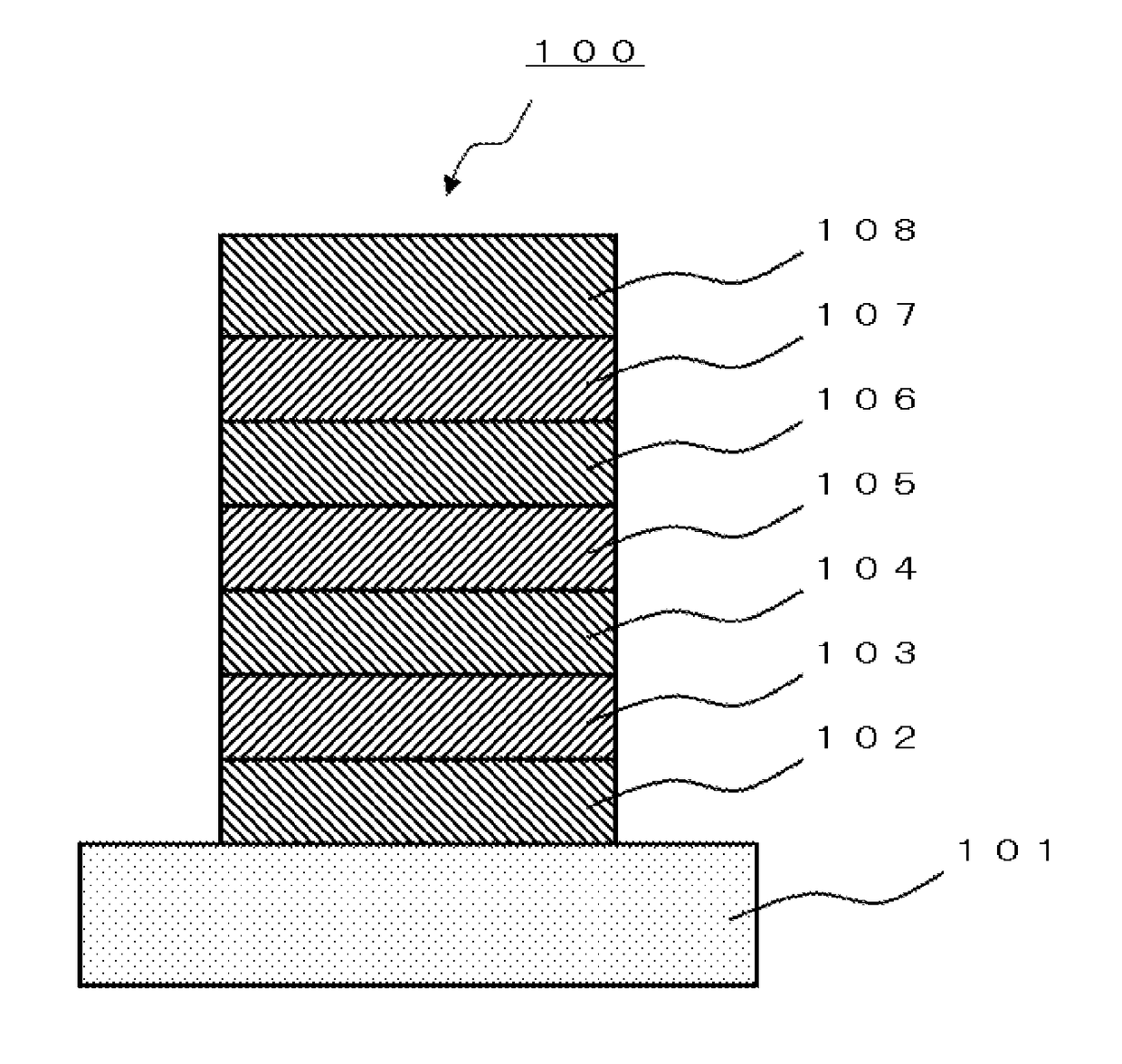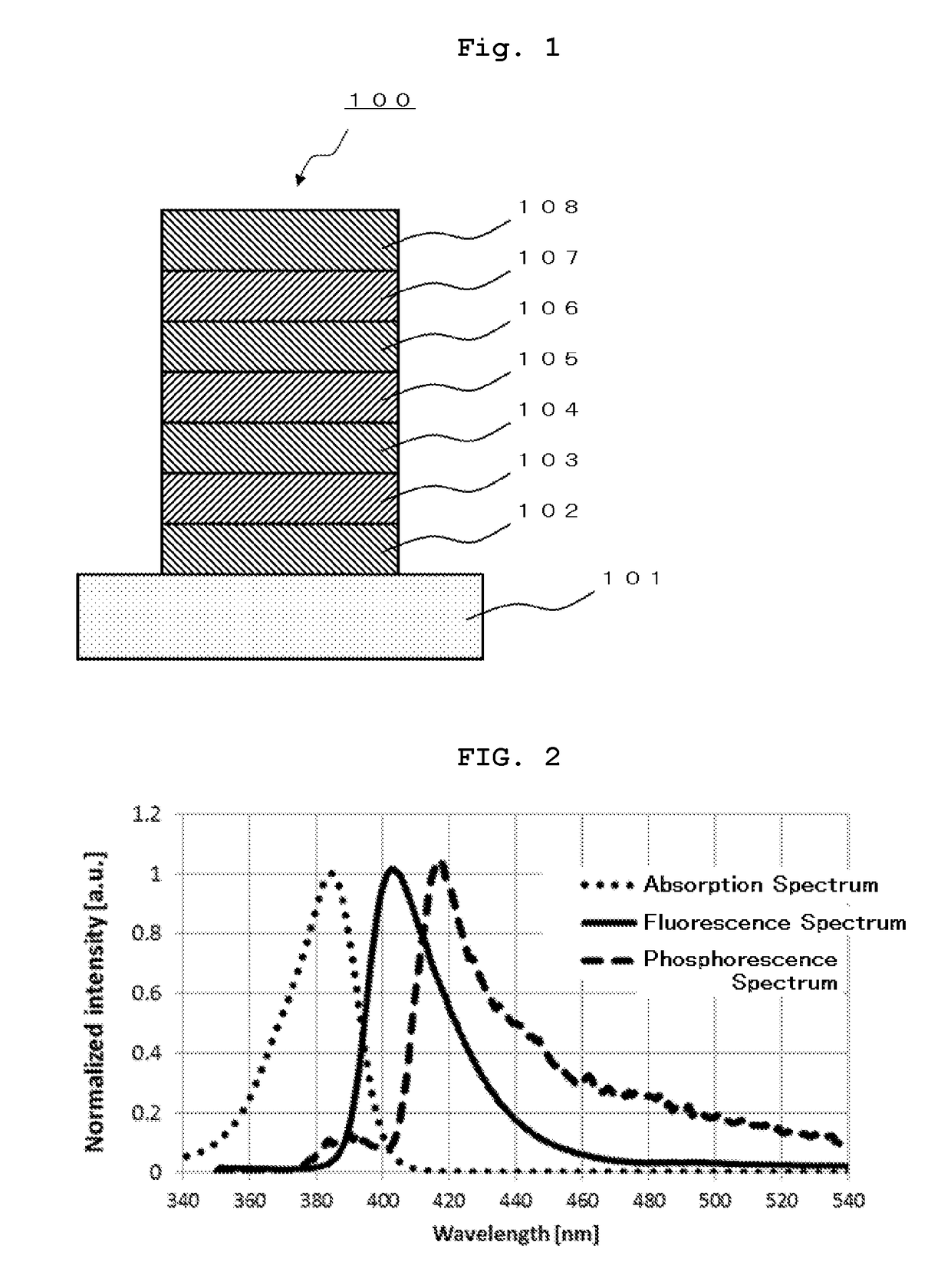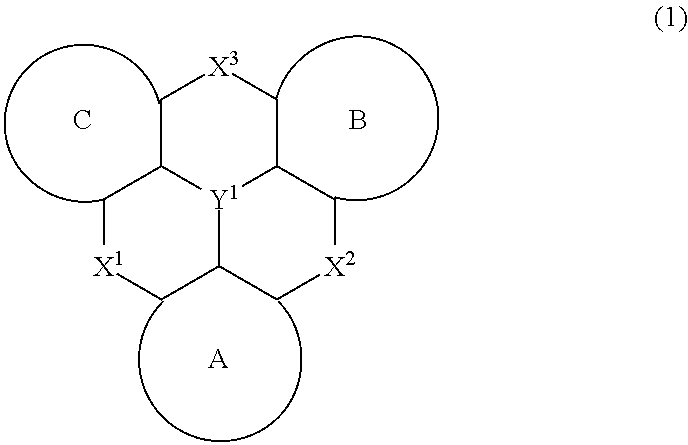Polycyclic aromatic compound
a polycyclic aromatic compound and electroluminescent element technology, applied in the direction of antimony organic compounds, germanium organic compounds, organic compounds of 3/13 elements, etc., can solve the problems of insufficient redox stability of aromatic rings having small conjugated systems, insufficient lifetime, and inability to describe a method for manufacturing other materials, etc., to achieve excellent organic el elements, reduce homo-lumo gaps, and high triplet excitation energy
- Summary
- Abstract
- Description
- Claims
- Application Information
AI Technical Summary
Benefits of technology
Problems solved by technology
Method used
Image
Examples
examples
[0244]Hereinafter, the present invention will be specifically described with reference to Examples, but the present invention is not limited by these Examples in any way. Compounds synthesized in Examples are illustrated below.
Synthesis Example (1)
N,N′,N″-triphenyl-8,12-dihydro-4H-4,8,12-triaza-12c-borazib enzo[cd,mn]pyrene
[0245]
[0246][First Stage]
[0247]To 1-bromo-2,3-dichlorobenzene [r-1] (22.6 g, 100 mmol), sodium t-butoxide (29.6 g, 308 mmol), 2,2′-bis(diphenylphosphino)-1,1′-binaphthyl [BINAP] (2.51 g, 4.0 mmol), bis(dibenzylideneacetone) palladium (0) [Pd2 (dba)3] (1.83 g, 2.0 mmol), and toluene (400 ml), aniline [r-2] (18.5 ml, 203 mmol) was added under a nitrogen atmosphere at room temperature, and the resulting mixture was heated and stirred at 100° C. for 26 hours. The reaction solution was cooled to room temperature, and was filtered using silica gel column chromatography, and a solvent was distilled off under reduced pressure to obtain a crude product. Thereafter, the res...
synthesis example (
10)
o-chloranil substitution product of N,N′,N″-triphenyl-8,12-dihydro-4H-4,8,12-triaza-12c-stibabe nzo[cd,mn]pyrene
[0312]
[0313]To a dichloromethane (8.0 ml) solution of N,N′,N″-triphenyl-8,12-dihydro-4H-4,8,12-triaza-12c-stibabe nzo[cd,mn]pyrene [compound (1-1221)] (30.7 mg, 0.050 mmol), a dichloromethane (1.0 ml) solution of o-chloranil (14.5 mg, 0.060 mmol) was added under a nitrogen atmosphere. The resulting mixture was stirred at room temperature for 3 hours. Thereafter, a solvent was distilled off, and the crude product was washed with methanol and hexane to obtain a compound (1-1341) (41.4 mg, yield 90%) as a yellow solid.
[0314]The structure of the compound thus obtained was identified with an NMR spectrum.
[0315]1H-NMR (400 MHz, CDCl3): δ=7.29-7.38 (m, 15H), 7.51 (d, 6H).
[0316]13C-NMR (101 MHz, CDCl3): 116.0 (6C), 116.9 (2C), 120.8 (3C+2C), 126.7 (6C), 129.7 (6C), 131.8 (3C), 140.7 (3C), 140.7 (3C), 143.8 (2C), 145.7 (2C), 150.5 (6C).
[0317]Other compounds of the present invent...
example 1
[0356]
[0357]A glass substrate (manufactured by Opto Science, Inc.) having a size of 26 mm×28 mm×0.7 mm, obtained by forming a film of ITO by sputtering and polishing the ITO film to 50 nm, was used as a transparent support substrate. This transparent support substrate was fixed to a substrate holder of a commercially available vapor deposition apparatus (manufactured by Choshu Industry). Tantalum vapor deposition crucibles each containing HAT-CN, TBB, TcTa, compound (1-1) of the present invention, Ir(PPy)3, TPBi, or LiF, and an aluminum nitride vapor deposition crucible containing aluminum were attached thereto.
[0358]Layers as described below were formed sequentially on the ITO film of the transparent support substrate. A vacuum chamber was depressurized to 2.0×10−4 Pa. First, HAT-CN was heated, and vapor deposition was performed so as to obtain a film thickness of 5 nm. Subsequently, TBB was heated, and vapor deposition was performed so as to obtain a film thickness of 65 nm. Furth...
PUM
 Login to View More
Login to View More Abstract
Description
Claims
Application Information
 Login to View More
Login to View More - R&D
- Intellectual Property
- Life Sciences
- Materials
- Tech Scout
- Unparalleled Data Quality
- Higher Quality Content
- 60% Fewer Hallucinations
Browse by: Latest US Patents, China's latest patents, Technical Efficacy Thesaurus, Application Domain, Technology Topic, Popular Technical Reports.
© 2025 PatSnap. All rights reserved.Legal|Privacy policy|Modern Slavery Act Transparency Statement|Sitemap|About US| Contact US: help@patsnap.com



